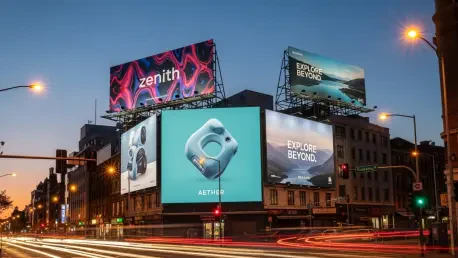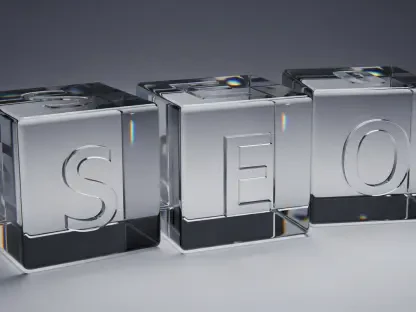Imagine walking through a bustling city center, surrounded by vibrant digital screens that not only catch your eye but also display ads tailored to the time of day, weather, and even your recent online searches. Digital Out-of-Home (DOOH) advertising has transformed public spaces into dynamic marketing platforms, capturing a significant 34% share of total out-of-home ad spend as of this year. Yet, despite its growing presence, many brands hesitate to dive in, held back by misconceptions about cost, reach, and effectiveness. This guide aims to help advertisers of all sizes overcome these barriers by debunking common myths and providing a clear, actionable path to leveraging DOOH for powerful brand connections. By following these steps, marketers can unlock a versatile and impactful medium to engage audiences in real-world settings.
The purpose of this guide is to equip businesses with the knowledge to navigate the often misunderstood landscape of DOOH advertising. Many assume it’s an expensive, unmeasurable, or limited tool, but the reality is far different. With technological advancements and data-driven strategies, DOOH offers unique opportunities to reach consumers at critical touchpoints. This resource will walk through the steps to dispel six major myths, offering insights into how this medium can fit into any marketing strategy, whether for a small local business or a large corporation.
Understanding the importance of DOOH is vital in today’s competitive advertising environment. Its ability to integrate with digital campaigns and deliver contextually relevant messages sets it apart from traditional methods. As the market for DOOH is projected to grow to $18.24 billion by 2030, staying informed about its true capabilities ensures that brands remain ahead of the curve. This guide serves as a roadmap to rethink outdated perceptions and embrace a medium that drives measurable results.
Understanding the Rise and Relevance of DOOH
Before diving into specific myths, it’s crucial to grasp how DOOH has evolved into a cornerstone of modern marketing. Unlike static billboards of the past, today’s digital screens are powered by programmatic buying and real-time data, allowing for dynamic content that adapts to audience behaviors. This transformation has made DOOH a key player in omnichannel strategies, connecting physical and digital experiences seamlessly. Advertisers who recognize this shift can position themselves to capitalize on a rapidly expanding medium.
The impact of DOOH on today’s market cannot be overstated. With billions of impressions managed across diverse networks, it reaches consumers in environments ranging from transit hubs to retail spaces. This adaptability ensures that brands can engage with audiences at multiple stages of their decision-making process. Industry projections highlight a steady upward trajectory, emphasizing the need for marketers to integrate DOOH into their broader plans to maintain a competitive edge.
Furthermore, the technological advancements behind DOOH have made it more accessible and effective than ever. Tools for data-driven targeting and campaign optimization allow for precise messaging that resonates with specific demographics. As more businesses adopt these innovations, the medium continues to redefine how advertising interacts with everyday life, making it essential to understand its full scope and potential.
Step-by-Step Guide to Debunking DOOH Myths
Step 1: Recognize DOOH’s Broad Scope Beyond Billboards
Many marketers mistakenly view DOOH as limited to roadside digital billboards, overlooking its extensive reach across varied locations. In reality, DOOH encompasses screens in malls, airports, gyms, elevators, and even medical offices, offering over 100,000 touchpoints through platforms managing diverse venue types. Start by exploring these environments to identify where target audiences spend their time. This broader perspective opens up opportunities to connect with consumers in settings that align with their daily routines.
To maximize this step, focus on contextual relevance when selecting venues. For instance, placing ads in fitness centers can resonate with health-conscious individuals, while screens in shopping centers can influence purchase decisions at the point of sale. Mapping out these touchpoints ensures that campaigns are not confined to a single format but instead engage viewers across multiple real-world scenarios. This approach enhances brand visibility in ways traditional billboards cannot achieve.
Step 2: Measure DOOH Effectiveness with Advanced Tools
A common misconception is that DOOH campaigns lack measurable outcomes, but this couldn’t be further from the truth. Modern tools like mobile location data, impression analytics, and brand lift studies provide detailed insights into metrics such as purchase intent and online conversions. Begin by partnering with measurement providers to track campaign performance transparently. This data-driven approach helps validate the impact of DOOH on audience behavior.
Integrating DOOH with other digital channels further enhances tracking capabilities. By connecting campaign results to online actions, advertisers can gain a comprehensive view of cross-channel effectiveness. Case studies from major brands demonstrate how these metrics translate into tangible results, such as increased website visits or sales. Leveraging such tools ensures accountability and builds confidence in DOOH as a reliable advertising medium.
Step 3: Utilize Cost-Effective Programmatic DOOH Options
The belief that DOOH is unaffordable for most brands often deters smaller businesses from exploring it. However, programmatic DOOH (prDOOH) offers impression-based pricing, allowing for flexible budgets and real-time optimization. Start by researching platforms that manage billions of impressions across multiple networks, ensuring access to efficient cost-per-thousand (CPM) rates. This affordability makes DOOH viable for a wide range of advertisers.
To implement this step effectively, focus on scaling campaigns based on budget constraints. Smaller brands can start with targeted local placements, while larger ones can expand to national networks. The key is to adjust spending dynamically, using programmatic tools to optimize for performance. This flexibility breaks down financial barriers, enabling businesses of all sizes to achieve significant reach without breaking the bank.
Step 4: Leverage Targeting Precision in DOOH Campaigns
Another myth suggests that DOOH lacks the ability to target specific audiences, but advanced data capabilities prove otherwise. Segmentation by demographics, location, time of day, weather conditions, and behavioral patterns allows for highly tailored messaging. Begin by identifying key audience traits and aligning them with relevant venues and triggers. This ensures that ads resonate with viewers on a personal level.
Crafting contextual ads using real-time data can significantly boost relevance. Studies show that a majority of consumers find weather-triggered ads useful, highlighting the power of timely messaging. Collaborating with supply-side platforms and data aggregators helps in selecting the most impactful screens for specific campaigns. This precision transforms DOOH into a strategic tool for delivering the right message at the right moment.
Step 5: Combine DOOH with Online Ads for Greater Impact
Some advertisers assume DOOH falls short compared to online advertising, but its unique strengths lie in real-world engagement. Unlike digital ads that can be skipped or ignored, DOOH captures attention in physical environments where consumers are more receptive. Initiate campaigns that use DOOH to drive brand awareness, complemented by online channels for conversions. Research indicates that a high percentage of consumers prefer DOOH over other media, reinforcing its effectiveness.
Additionally, DOOH often prompts immediate digital actions, with many mobile users engaging with brands after exposure. This synergy between physical and digital touchpoints amplifies overall campaign impact. Designing ads that encourage viewers to search for a product or visit a website can create a seamless journey from awareness to action. Recognizing DOOH as a complementary force enhances its value within a broader marketing mix.
Step 6: Make DOOH Accessible for Small and Mid-Sized Businesses
The notion that DOOH is exclusive to large corporations is outdated, thanks to programmatic technology and accessible platforms. Small and mid-sized businesses (SMBs) can now utilize DOOH to build visibility and target local audiences effectively. Start by identifying scalable solutions that cater to limited budgets, such as localized screen placements. This democratized access ensures that even smaller brands can compete on a larger stage.
For practical application, consider examples of local businesses using DOOH to attract nearby customers. A neighborhood restaurant might advertise daily specials on screens in surrounding areas, while a startup could focus on building recognition within a specific community. These targeted efforts demonstrate how DOOH adapts to various needs, offering tailored solutions regardless of company size. Embracing such opportunities levels the playing field for SMBs in advertising.
Key Insights from Overcoming DOOH Misconceptions
Reflecting on the steps taken, several critical takeaways emerge for advertisers navigating DOOH. The medium extends far beyond traditional billboards, reaching diverse venues for broader engagement. Measurable results are attainable through advanced analytics, while programmatic pricing ensures affordability across budgets. Precision targeting, real-world impact, and accessibility for smaller businesses further highlight DOOH as a versatile tool.
These insights collectively reshape how marketers approach out-of-home advertising. By addressing each myth with actionable strategies, the guide clarifies the medium’s true potential. Brands that adopt these lessons can confidently integrate DOOH into their plans, knowing it offers both creativity and accountability. This understanding lays a foundation for innovative campaigns that resonate with audiences.
Looking Ahead in a Digital-Driven Advertising Landscape
As the advertising world continues to evolve, DOOH stands poised to play an even larger role. Its integration with retail media and connected TV reflects broader industry trends toward seamless consumer experiences. Innovations in data usage and creative formats promise to enhance its capabilities further, though challenges like privacy concerns must be navigated carefully. Staying attuned to these developments ensures that campaigns remain relevant.
Projecting forward, DOOH is expected to solidify its position as a cornerstone of marketing strategies by 2030. Advertisers who adapt to these shifts can leverage emerging technologies to create more personalized and impactful ads. Keeping an eye on market growth and evolving consumer behaviors will be key to maintaining a competitive advantage in this dynamic space.
Final Thoughts on Harnessing DOOH for Success
Having walked through the steps to debunk myths about DOOH, the journey revealed a medium far more versatile and powerful than many had assumed. Each myth addressed—from scope to cost to effectiveness—uncovered actionable strategies that transformed perceptions. Marketers who took these steps likely found new ways to connect with audiences in meaningful, real-world settings.
Looking back, the process underscored the importance of challenging outdated views with data and evidence. For those ready to take the next leap, exploring DOOH platforms that manage extensive networks and impressions offers a practical starting point. Building on this foundation, advertisers could experiment with innovative campaigns, blending physical and digital elements to drive engagement. As the landscape continues to shift, staying proactive in adopting DOOH solutions promises to yield lasting benefits for brand growth.









